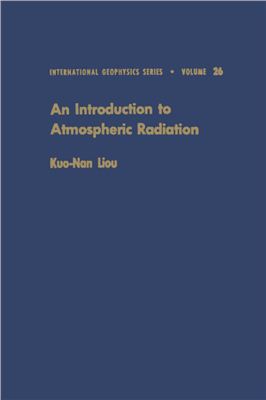Academic Press, 1980, 392 pages
The book is divided into eight chapters. Chapter 1 introduces concepts, definitions, various basic radiation laws, and the fundamental equations for radiative transfer. Chapter 2 describes the characteristics of the solar radiation that is available at the top of the earth's atmosphere. Chapter 3 is conceed with the absorption and scattering processes of solar radiation in molecular atmospheres. Photochemical processes involving ultraviolet radiation and ozone are discussed, and the concept of polarization and the scattering of sunlight by Rayleigh molecules are presented. Chapter 4 deals with infrared radiative transfer in the earth-atmosphere system. The fundamental theory of infrared transfer is covered, and absorption band models and the principle of radiation charts are discussed. Chapter 5 presents the single scattering processes involving aerosols and cloud particles in the atmosphere. The Maxwell equations are first introduced, and the solution of the vector wave equation, which leads to the Mie theory, is derived. The geometrical ray optics approach to light scattering by spherical water drops and hexagonal ice crystals is outlined. In Chapter 6, the principles of multiple scattering in plane-parallel atmospheres are introduced. This chapter includes the presentation of the basic equations, some approximations for radiative transfer problems, the principles of invariance, and various methods for solving the fundamental transfer equation. Applications of the basic radiative transfer theory to remote sensing of the atmosphere are given in Chapter
7. Discussions are made on the inversion principles used in determining temperature and gaseous profiles by means of satellite infrared sounding channels. Various inversion methods also are introduced. The uses of microwave Preface xi sounders, and the reflected and transmitted sunlight as a means of remote sensing are further discussed. The basic principles of radar and lidar backscattering techniques for cloud and precipitation detection also are described. The subject matter associated with radiation climatology is covered in the final chapter. This chapter introduces broadband radiation observations from satellites, and reports the latitudinal and global radiation budgets determined from satellite measurements. Theoretical radiation budget studies, and simple climate models based on the radiative balance are further described. Problem sets with varying degrees of difficulty are prepared in each chapter.
The book is divided into eight chapters. Chapter 1 introduces concepts, definitions, various basic radiation laws, and the fundamental equations for radiative transfer. Chapter 2 describes the characteristics of the solar radiation that is available at the top of the earth's atmosphere. Chapter 3 is conceed with the absorption and scattering processes of solar radiation in molecular atmospheres. Photochemical processes involving ultraviolet radiation and ozone are discussed, and the concept of polarization and the scattering of sunlight by Rayleigh molecules are presented. Chapter 4 deals with infrared radiative transfer in the earth-atmosphere system. The fundamental theory of infrared transfer is covered, and absorption band models and the principle of radiation charts are discussed. Chapter 5 presents the single scattering processes involving aerosols and cloud particles in the atmosphere. The Maxwell equations are first introduced, and the solution of the vector wave equation, which leads to the Mie theory, is derived. The geometrical ray optics approach to light scattering by spherical water drops and hexagonal ice crystals is outlined. In Chapter 6, the principles of multiple scattering in plane-parallel atmospheres are introduced. This chapter includes the presentation of the basic equations, some approximations for radiative transfer problems, the principles of invariance, and various methods for solving the fundamental transfer equation. Applications of the basic radiative transfer theory to remote sensing of the atmosphere are given in Chapter
7. Discussions are made on the inversion principles used in determining temperature and gaseous profiles by means of satellite infrared sounding channels. Various inversion methods also are introduced. The uses of microwave Preface xi sounders, and the reflected and transmitted sunlight as a means of remote sensing are further discussed. The basic principles of radar and lidar backscattering techniques for cloud and precipitation detection also are described. The subject matter associated with radiation climatology is covered in the final chapter. This chapter introduces broadband radiation observations from satellites, and reports the latitudinal and global radiation budgets determined from satellite measurements. Theoretical radiation budget studies, and simple climate models based on the radiative balance are further described. Problem sets with varying degrees of difficulty are prepared in each chapter.

